I don’t consider myself a Luddite at all. I am a big believer in technology and its potential to bring improvement to humans across the globe, despite its obvious challenges. And yet, in the world of photography, as I turn to film, I find myself evolving in the opposite direction when looking at where photographic technology is heading.
As I wrote in my post on the impact of AI on photography, we need to distinguish the experience of photography from the outcome. And for amateurs like myself, the experience is part of the outcome.
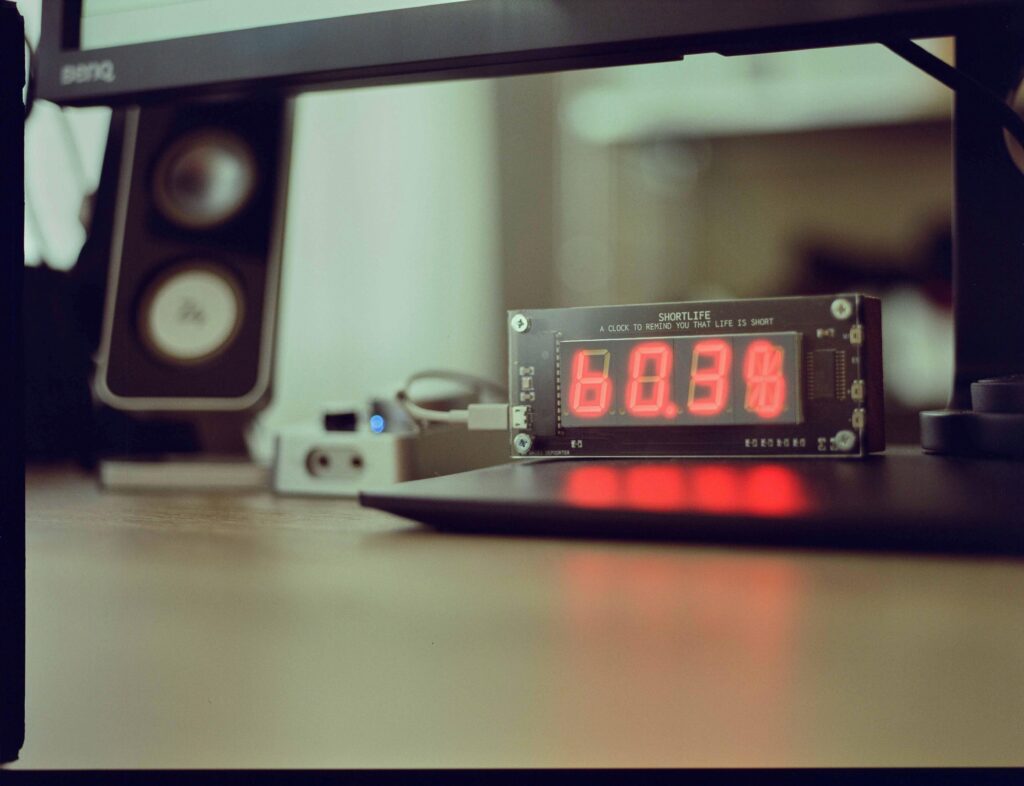
I have been looking for a shooting experience that has more distance from two things that have been getting in the way of my enjoyment of photography. One is looking through screens. I know it’s efficient. I know having that WYSIWYG view has benefits. But I find myself looking for a photography experience without screens every once in a while.
My Leica M also qualifies here, of course. But film is yet another step away from immediate feedback. It is this detachment from the process of taking a photo and the actual photo itself that appeals to me. No instant feedback on what you tried to capture. Again, I could have looked for an M-D or simply disabled the screen on my digital cameras. Yet somehow, this is not the same.
The other thing is the impact of abundance. This has a curious influence on the creative process. I was never a high-volume shooter, but effectively having a never-ending amount of storage these days is something that can trigger a mindset where you shoot everything that moves. And then shoot a few more times again, just to be sure.
For professionals, this is great. There is no need to worry about getting that perfect pose and facial expression. Or that unique moment in sports or in street photography as passers-by line up for a great composition. But for an amateur, this can be exhausting. Having to sort through endless quantities of photos doesn’t make anyone happy. Lightroom and Capture One Pro are getting better at helping you sort and cull during the import process. But still….
Shooting in fixed series because of film capacity is something that I really appreciate. The capacity of the number of photos from a film roll provides a natural break in comparison with digital, where you have the possibility of an almost endless series of shots given the large storage options available today.
For someone who made the film to digital switch, this might be obvious. However, for me, who started to truly get into photography in the digital era, this is a welcome change.
I used some film point-and-shoot cameras in my youth as a tourist, but that was it. Then, the limitation of having only so many shots on a roll was annoying. Now, when I am in the mood for it, I quite like it. The ability to pick a digital camera or a film camera, depending on the photographic mood or setting, is a wonderful thing to have.
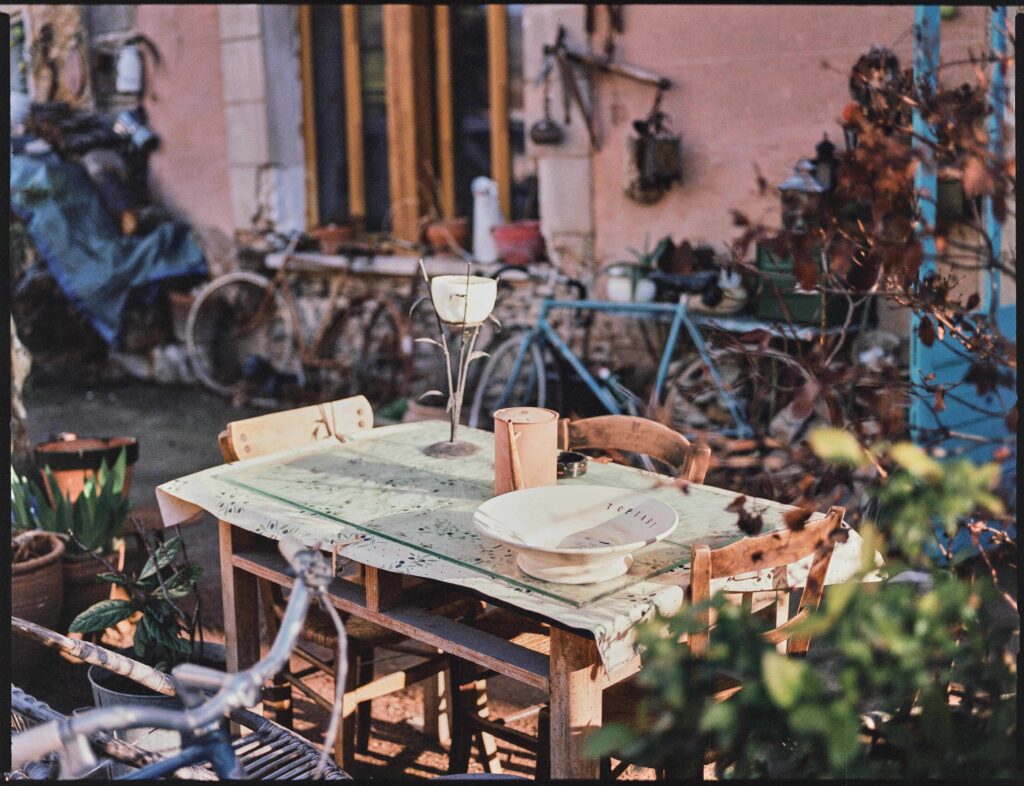
So far, I’ve talked only about the issue of abundance from the perspective of the photographer. We all know what it feels like as a spectator, having to sit through endless photos from someone’s holiday.
Less truly is more, in this case. Now, you don’t need to shoot film to bring some much-needed restraint to your photography. You can do that when shooting digitally as well. It just takes a lot more discipline to do so.
So far, I find the influence of shooting film occasionally very helpful in my digital work as well. It helps me assess the photographic potential of a scene with much more urgency.
It is teaching me to raise the bar in terms of what I want to capture, digital or not. I enjoy this, but many people might not and think this is an odd limitation that is completely unnecessary.
I have decided to shoot medium format, or 120 film, where this limitation is even stronger compared to 35mm film. Every roll in my current film camera (more on that below) holds a whopping amount of 12 photos. Talk about constraint.
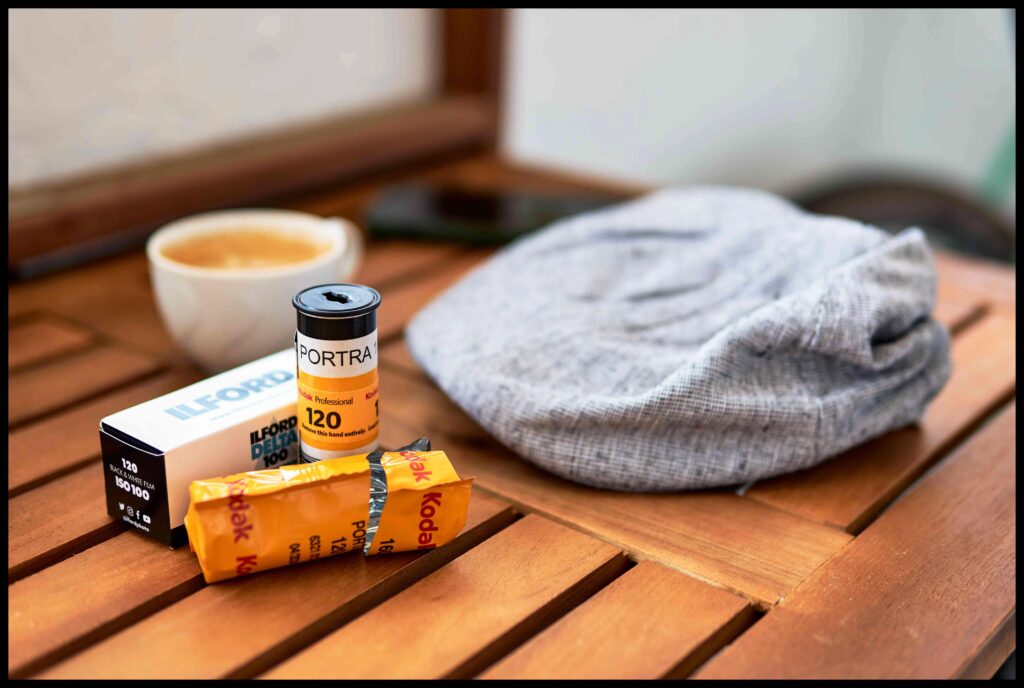
The physical aspects of shooting and processing film are quite different compared with digital. There is something about taking a roll of film and getting your film camera ready to shoot. After taking a photo, the feedback from the lever to move the film forward is a very tactile experience.
You have just completed the process of capturing light and are ready for the next one. Slow and conscious. Receiving your negatives is another happy moment in the journey of shooting with film. I don’t develop film at home, but have a lab do it for me. I will start to self-scan, but so far, I have let the lab do that for me as well.
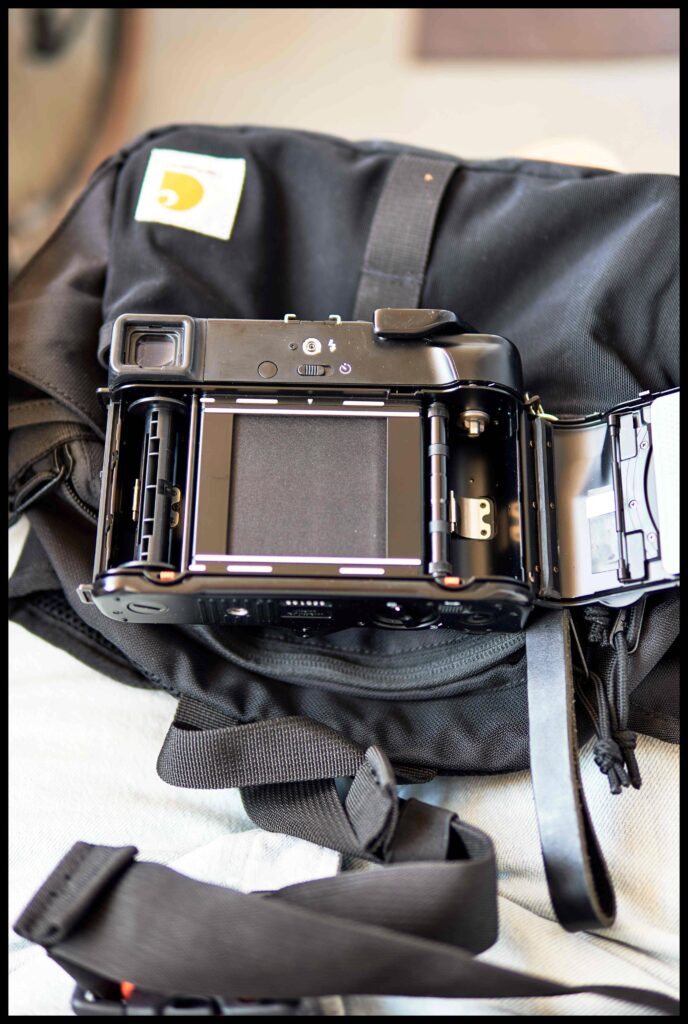
And then there is the look of film. It depends on which film stock you use, obviously, but the ones that speak to me, such as Kodak’s Portra 400 or 160, have this interesting mix of sharp softness. The lens you use will be of influence here, but the way light is captured chemically versus digitally does make a difference.
It’s not better or worse, but simply different. I enjoy it. The colours, with the right film stock, are something else. Especially when shooting 120 film. It’s hard to describe, but there is a vividness without becoming over-saturated, as some digital photos can quickly become. I picked medium format film over 35mm because of that colour look. I will shoot black & white as well, but the big appeal to me is the colour.
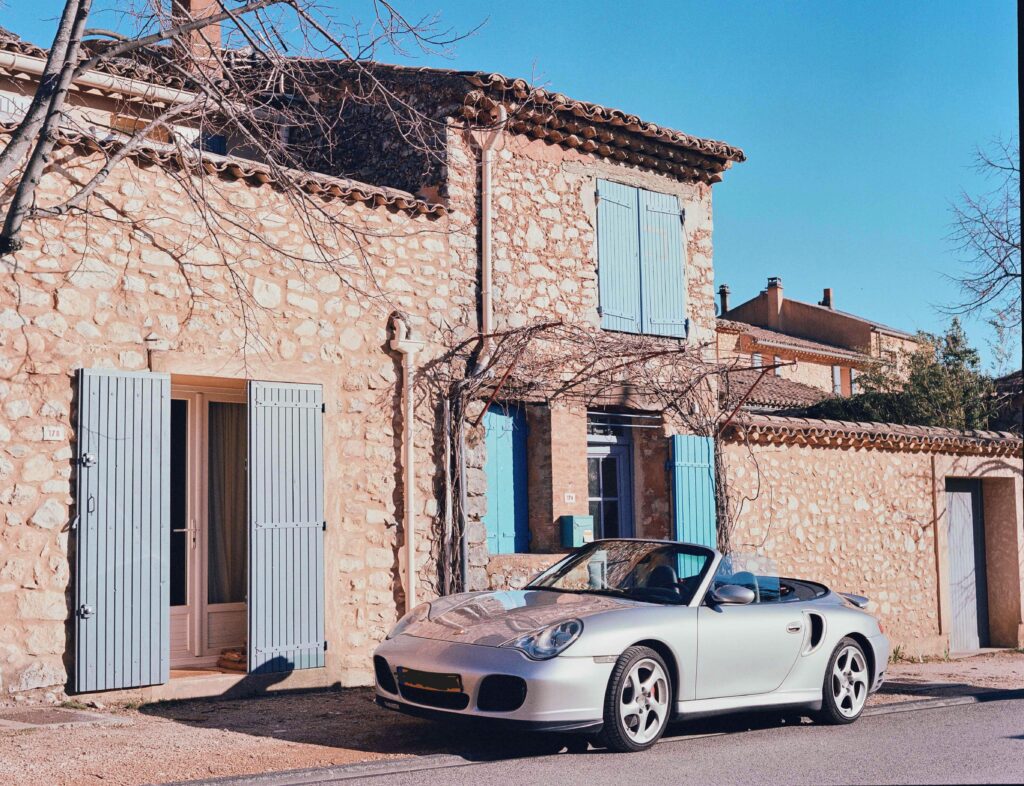
The elephant in the room when talking about film photography is, of course, how expensive it has become. Twelve shots per 120 film roll against about €15 per roll and €7 for the development means it costs €1.80 for every shot. And then you have only a negative. Printing costs more. Scanning can be done more cheaply at home with some initial investment in a lightbox and a film holder.
But shooting film is expensive, very expensive. This adds to the state of selective shooting that the lack of frames on a roll already introduces. Because you could just load another roll, right? Well, yes, but that would add up….
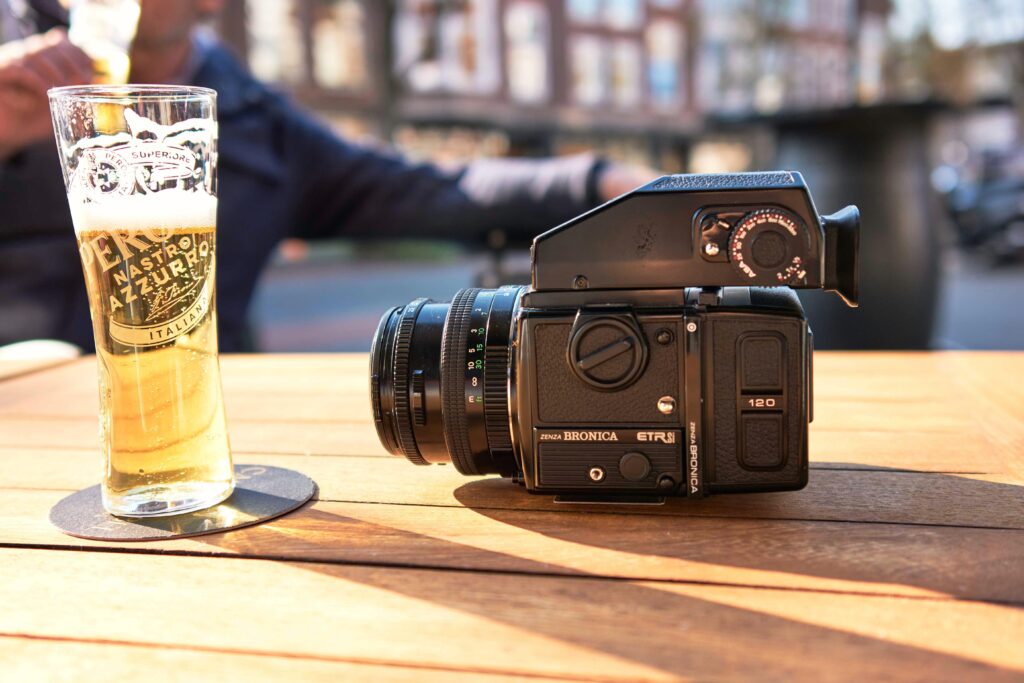
Finally, you need a camera. This is also not cheap. With many people getting into film, especially medium format, and almost no new medium-format film cameras being made any more, getting your hands on a good camera can be expensive as well.
I didn’t want to break the bank when trying out film photography, so I bought a Japanese Hasselblad 500-inspired 645 camera called the Bronica ETRSi. Long story short, I don’t like it. It turns out that waist-level viewfinders are not my thing, and the ergonomics of this boxy camera didn’t work for me. I did like what came out of the camera, and the standard 75mm lens is great.
Even though I didn’t like the Bronica, I had seen enough. I wanted to continue with film. Days and nights were spent browsing the internet to learn about this new world of cameras that I was completely oblivious to.
Finally, I decided to go for the Mamiya 6. It is a 6×6 square format, absolute beauty of a rangefinder, with a collapsible lens. It also has a 75mm lens; this comes down to an ever-so-slightly-wider 35mm equivalent of 41mm compared with the 46mm of the Bronica. I love the 40-ish focal length for a single-lens camera. I will write a separate post about this wonderful tank camera.
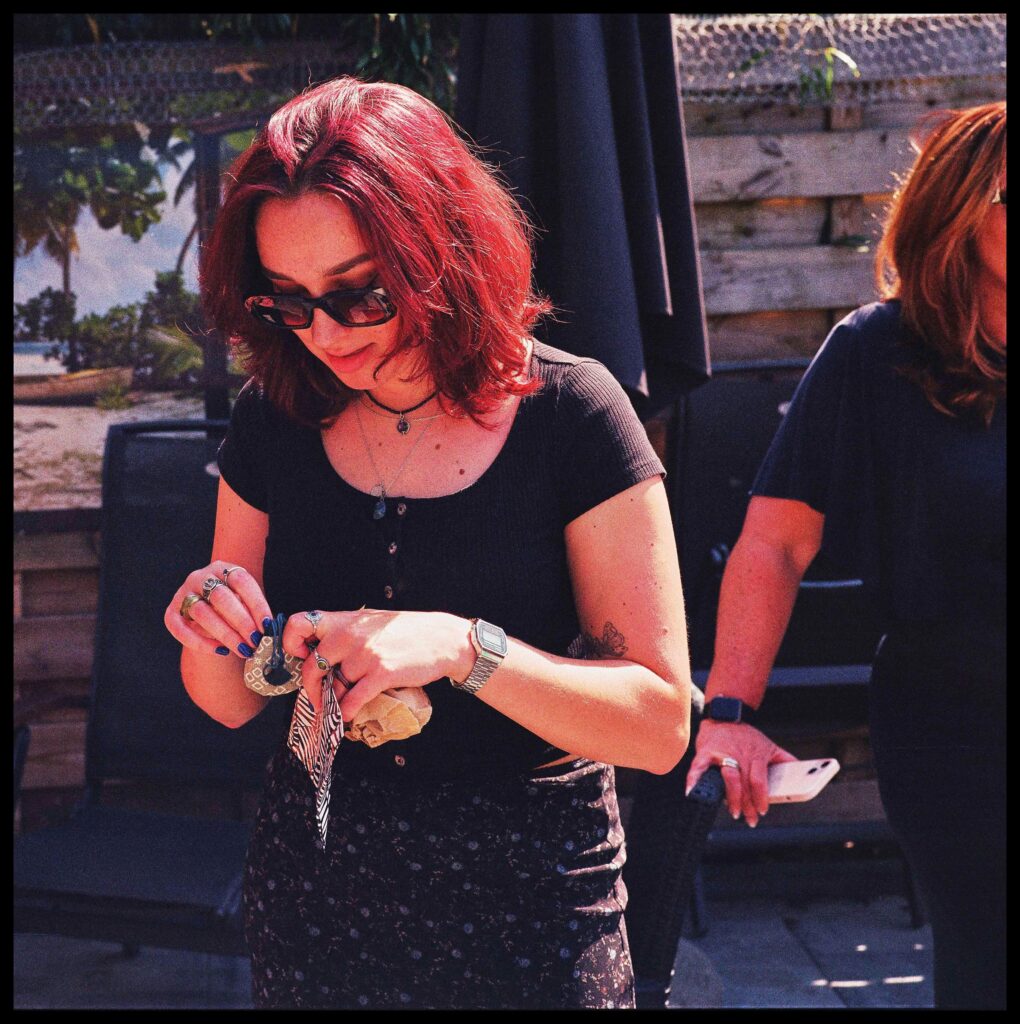
Back to my analogue expectations. What am I looking for by shooting film? For one, I will enjoy the process. It really is different from shooting digital. From the way my Mamiya light meter works compared to those of modern digital cameras to the fact that composing in a square format will push me through a hard learning curve, I am enjoying the newness of it all. And I think I already know this is not just chasing novelty. I am seriously falling in love with this kind of photography, and the Mamiya 6 is living up to what I was hoping for. To be continued…
Read more from Erwin Hartenberg
Visit the author’s website
Join the Macfilos subscriber mailing list
Our thrice-a-week email service has been polished up and improved. Why not subscribe, using the button below to add yourself to the mailing list? You will never miss a Macfilos post again. Emails are sent on Mondays, Wednesdays, and Fridays at 8 pm GMT. Macfilos is a non-commercial site and your address will be used only for communications from the editorial team. We will never sell or allow third parties to use the list. Furthermore, you can unsubscribe at any time simply by clicking a button on any email.

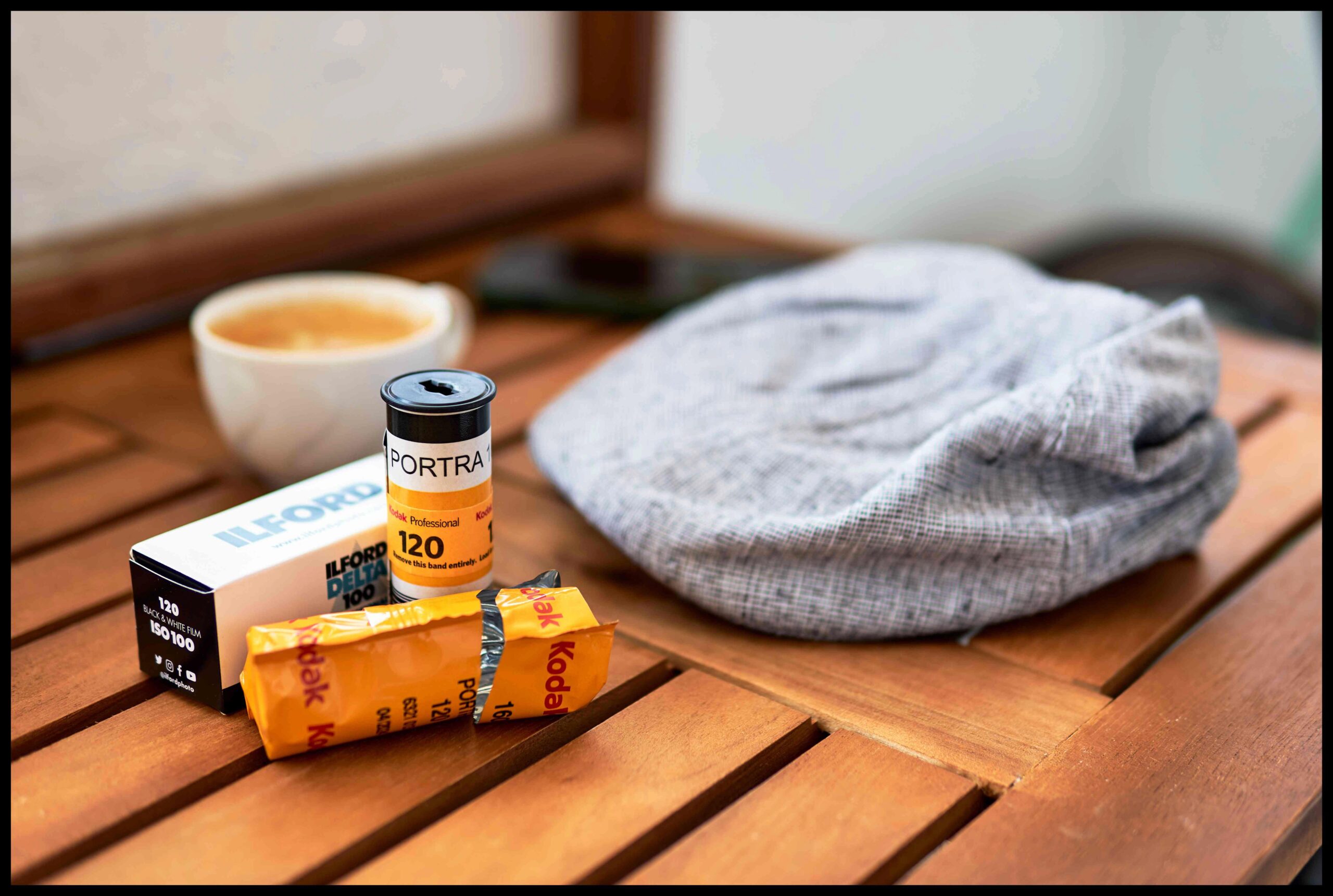
Time for half-frame! 72 exposures from a single roll and lots of artistic capabilities/ Please check out the Olympus Pen F for a fabulous camera with an amazing selection of lenses. You will certainly be impressed.
There’s two Martins? Where do you hail from? I am in Florida.
Recently I was debating having one of my Nikon Dfs converted to monochrome. The only service currently available costs $2500. A bit steep.
So I thought, I already have film cameras. I can buy a lot of film and processing for $2500! Why not just shoot actual B&W film?
Martin, for your future information, any comment including a link is set aside for moderation. I try to approve as soon as possible. The reason for this is they spam comments invariably contain a link so the message is flagged as suspect.
I saw you posted this twice, perhaps thinking it hadn’t been sent, so this is just to set your mind at rest. Mike
You guessed it, Mike. Thanks for letting me know.
Here’s my two pence. On Monday I spent £23 having a roll of Ilford XP2 developed and scanned along with a new roll of film. Assuming I get one photo that I print and keep I’ll be happy. The negative should outlast me, as is the case of a negative of my father from about 1934. He died in 2012. Price per year will be negligible. My digital files? I’m not so sure.
Well, XP2 is chromogenic, right? So, not to rain on your parade, but better buy some silver emulsion film. Just sayin’. [:-)
That said, my Kodachromes from 1970s are still doing OK.
Anyway, I take your point. Not only do we not know if the digital files will last, we don’t even know if there will be any way to read them in the future.
Thanks for the tip Martin. I am rediscovering B&W film so this idea is new to me. I’ll check it out. Any recommendations for fine grain high ISO B&W film?
Kevin, here is a link to a site I find very useful for films currently available. Many brands that did not exist in the heyday of film. There are columns for ISO and grain size.
Note the tabs for the three main types. You will see XP-2 listed under C-41.
https://thedarkroom.com/film-index/
Thanks Martin, appreciated. Kevin
Dear William,
sorry, “dead and stupid” was really an inadequate expression. No Camera deserves it!
But thank you for your remarks, they really gave me a deeper insight in the analouge world. To answer your final question: I am working on a little exhibition about the daily life in naples. Last year I took many photos there with the M262 and the M3, equipped with “Silbersalz Films”. Many digital and a few rolls of film were produced. The Photos i Liked most were analouge. Like many other users i cannot describe the magic appearence in technical Terms like “dynamic range” or so.
Anyway now I seriously try to chance complete to film when I make my next shooting in September.
Kind regards
Günther
Thanks, Gunther. You have mentioned something that is not often mentioned in all the talk about time, convenience and coat and that is the look of the film images. However much people try to give a ‘film look’ to digital images, this never, in my opinion, succeeds in matching film, particularly as regards the great colour slides, such as Kodachrome or Fujichrome, or even black and white films such as Tri-X. ‘Analogue’ is a not a term you will ever see or hear me using in respect of photography. In recent years, it seems to have been hauled in to explain to young folk that this is ‘not digital’. If you go back to the 1990s, 1980s or any earlier era you will not find the term ‘analogue’ being used in respect of photography. Last week I was leading a group through a darkroom from the 1880s, explaining photography using glass dry plates. I would have felt like an idiot describing that as ‘analogue glass dry plate photography’, although, you never know, some genius might come up with ‘digital glass dry plate photography’ one of these days. I prefer the term ‘film photography’ (except where plates are involved) although that might get confused with photography for the cinema. I never use the term ‘movies’, preferring the term ‘films’. However, when I was a child we never went to films or movies, we just went to ‘the pictures’. Mike will know what I am talking about. What we saw on the screen in those days came from projected film and we were very happy with how it looked. We certainly never thought of calling it analogue as we went home happily playing out scenes from ‘the picture’ we had just seen.
William
“‘Analogue’ is a not a term you will ever see or hear me using in respect of photography. ”
Thank you, thank you!!
I’ve discussed this with William many times, and I know his aversion to the use of “analogue”. While it has come to refer to something that is not digital and old, it’s a poor substitute for “film”. Curiously, we don’t hear vinyl records being described as analogue; more often it is now just “vinyl” which, of course, doesn’t describe every record. So I think we should standardise here on Macfilos on “film” as the opposite of “digital”. Discuss…
Mike
Thanks, Mike. I still say LP or 45 instead of ‘vinyl’, but at least that term describes the constituent material. I don’t call my 78s ‘shellacs’, though. As for ‘albums’ these were originally like photo albums with 78s inserted into pouches within. A couple of years ago I picked up a Louis Armstrong album from the 1940s which contained pouches with 4 double sided 78s with 8 songs/tunes from the 1920s when Louis first started recording. As for the modern re-issues of jazz LPs from the 1950s and 1960s these are sometimes advertised as being cut from the ‘original analogue tapes’, an expression that never would have been used when the original LPs were issued 50 or 60 years ago. The world is being redescribed in a way that sometimes jars for those of us who can remember ‘way back when’.
William
A very good idea! From now on I use “film” instead of “analogue”.
Günther
+1 on film. Not being a native speaker, I also went back and forth between the two terms (don’t get me started on the US vs UK spelling 😉 ). Film captures it well because that is ultimately the medium after all.
Dear Erwin,
thank you for this very interesting article. But for me there is something, that I really hate when I shoot analouge. Shooting a whole day, I bring the camera in the hotel and then it stands there, less ore more beautifull. But the camera does noithing, a dead stupid thing. You cannot see, what you have done done the whole day. Not for weeks. So I use a digital Camera as a Backup. Each film picture is also taken with my M262. So for me this problem is solved.
Best regards
Günther
Dear Gunther, for decades, indeed a 170 years or more , this what we did, although during the wet plate era we had to process images before the plate went dry, say within 15 mins. Whatever happened to patiently waiting and the anticipation of and the joy of actually seeing the final image when it arrived? This is how it was for many of the great photographers such as Cartier Bresson and Erwitt and Lange etc. Their work did not turn out badly and it was, for them, worth the wait. The world has changed, though, and instant gratification with social media is the name of the game. I saw an Instagram post yesterday which was about a man telling a Rip Van Winkle from the 1950s that he had a tiny device in his pocket which would allow him to access all of the wisdom known to mankind. When ‘Rip Van Winkle’ asked him what did he use it for, he said “taking photographs of cats and having arguments with complete strangers”. Not only has the technological world changed, but we have changed with it. I remember a time when nothing was digital and we were all very happy and knew a lot about what was happening in the world. We liked ‘one hour photo’ shops when they opened, but Kodachrome slides often took a week to arrive back. The magic of opening the little yellow box and looking at the slides has yet to be matched by anything in the digital world.
I will let you into a little secret though. I have, on occasion, used a digital M camera as an ‘exposure and distance mule’ for early cameras (including Leicas without rangefinders or meters). Often, I would not take an image with the digital M, but, even if I did, it would be the film image that I would use afterwards. Finally, I would never call any camera, no matter how old or decrepit, a ‘dead stupid thing’. I always regard the lens of any camera as an ‘eye’ that has seen many things. You can either imagine them or better still find the images which the lens has created. See the ‘Swiss Photos’ articles on Macfilos to see what I mean.
One final question. Do you use the film images or do you take the ‘easy way out’ with the M262 images? Thanks for your thought provoking post. It certainly provoked a few for me.
William
” . . . a man telling a Rip Van Winkle from the 1950s that he had a tiny device in his pocket which would allow him to access all of the wisdom known to mankind. When ‘Rip Van Winkle’ asked him what did he use it for, he said ‘taking photographs of cats and having arguments with complete strangers’.”
I love it!
The “taking photographs of cats” part justifies the existence of smartphones. The other, not so much.
Dear Erwin, thanks a lot for sharing this article, the images and your experience. I fully agree that for many of us, the process of taking images is part of the outcome – and yes, the process is very different when you shoot film. I am just coming back from travelling, and I shot digital and analogue side by side. Nothing I would to again witout a clear need. It is better to (pun intended) focus on what you really want to do at a time. In general, however, I expect to work in both worlds, and this will cuase no stress to me. I shot the first 15 years of my photographic “career” or so so many rolls that I don’t think I will lose the skills for it. And cost? Shoot with concentration and buy no new digital camera for the next five years. This way, you can afford to take as many analogue images as you want… Jörg-Peter
Thanks Jörg-Peter. I agree on choosing a format and immersing yourself in it for that trip or occasion rather than shooting side by side.
I am a retired high tech executive that used to be an electronics, fiber optics, and radio frequency expert. I have been steadily simplifying my life and going back to basics. No Facebook, automated car modes, and so on. I’m will not go back to film but I use my camera as if I was using film: centre weighted metering, no AI focusing, manual focus when possible, M mode or A mode and so on.
I really enjoyed this article!
Thanks for an interesting article, Erwin. Even when shooting with digital, I realise I’m in ‘semi-analogue’ mode – certainly no Gatling gun approach to shooting (as you say, a pain to sort through so many images afterwards) but I instinctively batch each download from the camera by subject, rather than waiting till the card’s full with several different occasions (all of course lost, if the card – or the transfer – should fail).
I still try to shoot one (35mm) film a month, purely for personal satisfaction, commercially processed then selectively scanned at home with a dedicated film scanner – the perfect combination for me (apart from the laziness factor, my domestic water supply is full of agricultural ‘floaters’, which delight in sticking themselves to film emulsion).
On the subject of film cost, I wonder if such photography is stealthily returning to the days when it was restricted to the wealthy enthusiast. In conjunction with soaring insurance costs for private cars, making personal transport unaffordable for many, and the ever-increasing price and carbon-guilt of flying abroad for foreign holidays, perhaps there’s a secret agenda to return us to the 19th century!
“On the subject of film cost, I wonder if such photography is stealthily returning to the days when it was restricted to the wealthy enthusiast”.
When I first began serious photography, I was at University (omitting the article “the” in deference to all you Europeans), I was on a very tight budget, using money I had saved from summer jobs, not any of my father’s funds. So I did B & W and had my own makeshift darkroom. Colour (ditto) slides were an infrequent luxury.
Fast forward to the late 1990s / early 2000s: film was unbelievably cheap, especially color negative, and processing even cheaper. Those were the days.
Now it is like the early days for me: film rather expensive, processing getting to be that way.
Great article
I have kept my analogue 35mm Nikon FM3a for many of the same reasons Oh and another thing they weigh a lot less too- this is one reason I await a Q3 after humping Digital up peaks and crawling around in confined spaces for the last sixty years my shoulders and neck are suffering
As regards expense of film development do pick a reputable Lab as cheap and cheerful en prints may just as well have been taken on a box Brownie on a foggy day at the fun fair or gas works… talking of which I do miss the 32ASA (ISO) monochrome slide film for industrial landscape work
If memory serves, it was Kodak Panatomic X developed with Kodak Direct Positive reversal chemistry.
Thanks Martin
I must admit I had not used this-or even heard of it then or now. (What ASA/ISO?)
I used Agfa and I think it was processed by the maker in Germany and returned in the 35mm strip (useful) with card mounts separate As a foot note my favourite image/pic was of a ferry crossing the River Tyne one frosty, rimy November morning taken on a Zenit B with the better(?) Helios Lens…”The Fog on the Tyne is all Mine…”
Panatomic X was rated at 32 ISO. (I still think ASA!). I can’t remember ever using it. I really liked the look of TRI-X developed in D76. The grain was actually attractive to me.
In the final years of film for me (well, not final if I start again) I liked Kodak Technical Pan developed in Technidol LC. Extremely fine grain, and a low ISO to match (25)’
The ‘modern (-ish) equivalent is probably the Czech-born Fomapan R, a black & white reversal film, though admittedly 100 ASA/ISO. AG Photographic claim to have a few in stock …
Thank you Tony and Martin
Very interesting article. Worth pondering, as i came across a mint quality Ikonta in a pristine case the other day when I was going through my cameras! Fancy having had that in a drawer for many years and never used! Maybe I was waiting for your post.
I have transitioned from film to digital without much of a lookback or any major regrets. Still, I keep several SM and film M Leicas, as well as a Rolleiflex TLR and a Super Ikonta just in case. I sold my Nikon and ‘Blads 8 years ago, I think. My last roll of film was about 8 years ago also, chromogenic black and white in an M2. I got one wonderful shot on that outing, right up against the film running out. That image was of a group of people walking up the cable of the Golden Gate Bridge, silhouetted abstractly against the sky, with the city far below. It made the cover of LSI’s Viewfinder. But I could have made the same shot with digital, if I had had one with me.
For me, the way I shoot digital, the only change from film is that I know I can shoot at ridiculously high ISOs, so I can therefore avoid camera-shake, and, most importantly, that I don’t have to be as precise in exposure because I can open up several stops of underexposure successfully in PS. So I have optimized my M10s for 1/3 stop underexposure right off the bat, and try hard not to overexpose. I therefore feel freed up considerably; I was never that good at guesstimating light values anyway.
But I still mostly act as though I have film in the camera. For my M10-M I have bought an Arte di Mano case that comes with a back cover. I try to avoid chimping this way, and therefore attempt to keep my mind on exposure and composition, like I would have with a film camera. I try for a decisive moment style and do not take very many pictures of a subject; never have. I also have a Hobby Japan Thumb Rest Lever on each M10 — that makes the camera like an ersatz M10-D. The feel of the pretend rewind lever is very comforting and familiar to me. It also fools many subjects into thinking I am a harmless old man with an antique (to them) camera.
Please don’t get me wrong. In the old days I would obsess happily about what emulsions to take on a trip as much as I would about which lenses. I loved darkroom work. But with digital I feel so freed up, once again. To concentrate on making images that I feel have some content in them, and longevity about them. So, I don’t look back to film very often. Still though the nagging question about the lack of an original digital negative, as it were. I save my raw files, but that is not enough.
Ed
Erwin
This is a heartfelt article, yearning back to a previous age. Yet it was only in 2012 that I went totally digital, eleven years ago. I still have several rolls of Velvia 50 and Ektar 100 in my deepfreeze and they should still be usable for a couple of years yet. I keep reminding myself I should load them and use them, but somehow I don’t get round to it.
However for me, as I get older, my enjoyment is the convenience of having a high quality digital travel camera (Sony RX100 Mk6) available at all times and “snapping” photographic opportunities as they arise. Lugging heavy kit around even for pre-planned sessions has lost its appeal. My Manfrotto tripod weighs a ton!
You mentioned, “I picked medium format film over 35mm because of that colour look”. I agree the images from film are just different from digital, but does film size also make a difference to colour itself? I accept there is less grain with larger negatives.
Enjoy your 6 x6 format and no doubt grey graduated filters will come in useful when taking landscapes. I look forward to your next article.
Chris
Chris, I wrote an article here about six years ago called Rolleiflex: 120 film = More Megapixels? I think that Mike made up the title as I have never been a pixel peeper or counter, but once you see a medium or large format negative you can see the difference immediately. However that does not mean that you have to use a Rolleiflex camera all of the time. In my experience you can use it just when you want what it can provide and you can leave it at home the rest of the time. For travelling I find that the smaller the camera I can get away is what suits me best, so most of the time a Leica M (film or digital) and a smartphone do for 90% of my photography. It is only for sports or wildlife, which I rarely photograph these days, that I might need something ‘longer’. Lugging around something large like a Leica SL or a professional DSLR with a large zoom is something that belongs to the past for me.
A lot of people, myself included, just prefer the ‘look’ of film. One point which Erwin made and which I forgot to comment on before is the skyrocketing cost of film. This is bad in an obvious way, but it might also be good as regards making photographers consider each and every shutter click and develop a sense of what really matters in photography. The spray gun approach, that often comes with digital, is not a good teacher.
William
What a great article. I shot 35mm for 47 years before transitioning to digital. I have been fully digital since 2014. Now, strangely, I find myself being drawn back to shooting film. How it works out, remains to be seen.
On the point about colour; I don’t know why exactly from a science point of view but when comparing similar photos taken of the same scene on 35mm and 120, I do see colour differences. Granted, they would be taken on different cameras and lenses so that plays a role. But perhaps the fineness of capturing light in 120 does create richer information in the colour vs 35mm.
I have used 35mm film regularly this year for the first time in about 20 years. I have mainly used my trusty M6 with Portra 160/400, but I also shot a roll with a Leica Compur B from 1928, which was a different kind of experience with no rangefinder and a shutter that is disconnected from the wind on. I have rolls of 120 and even 5×4 sheet film which I intend to use if I can get myself away from the large amount of photography admin work that I have become involved with in various organisations. Yesterday I did a talk about and led a group around a 135 year old darkroom. Strangely enough, the glass plates from that era have survived better than the early celluloid negatives, but I can’t see glass plates making a comeback anytime soon.
William